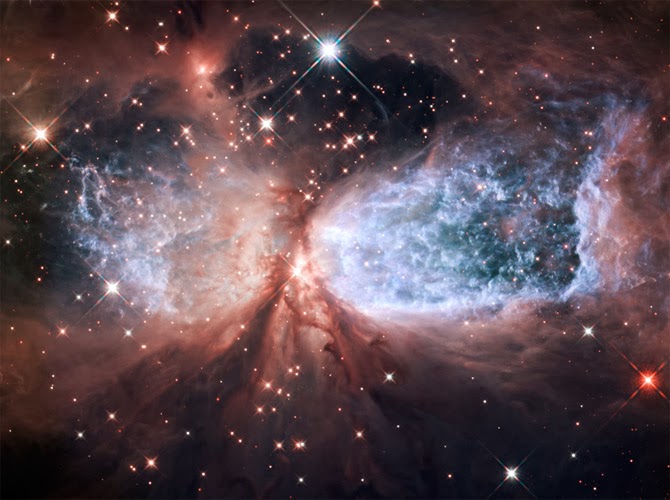The striking Sharpless 2-106 star-forming region is approximately 2,000 light-years from Earth and has a rather beautiful appearance. The dust and gas of the stellar nursery has created a nebula that looks like a ‘snow angel.’
NGC 3314 is actually two galaxies overlapping. They’re not colliding – as they are separated by tens of millions of light-years – but from our perspective, the pair appears to be in a weird cosmic dance.
To celebrate its 23rd year in space, the Hubble Space Telescope snapped this view of the famous Horsehead nebula in infrared light. Usually obscured by the thick clouds of dust and gas, baby stars can be seen cocooned inside this stellar nursery. For the last 23 years, Hubble has been looking deep into the Cosmos returning over a million observations of nebular such as this, but also planets, exoplanets, galaxies and clusters of galaxies. The mission is a testament to the the human spirit to want to explore and discover.
Light from an ancient galaxy 10 billion light-years away has been bent and magnified by the galaxy cluster RCS2 032727-132623. Without the help of this lensing effect, the distant galaxy would be extremely faint.
This is 30 Doradus, deep inside the Tarantula Nebula, located over 170,000 light-years away in the Large Magellanic Cloud, a small satellite galaxy of the Milky Way. 30 Doradus is an intense star-forming region where millions of baby stars are birthed inside the thick clouds of dust and gas.
Arp 116 consists of a very odd galactic couple. M60 is the huge elliptical galaxy to the left and NGC 4647 is the small spiral galaxy to the right. M60 is famous for containing a gargantuan supermassive black hole in its core weighing in at 4.5 billion solar masses.
With help from the Karl G. Jansky Very Large Array (VLA) radio telescope in New Mexico, Hubble has observed the awesome power of the supermassive black hole in the core of elliptical galaxy Hercules A. Long jets of gas are being blasted deep into space as the active black hole churns away inside the galaxy’s nucleus.
NGC 922 is a spiral galaxy with a difference. Over 300 million years ago, a smaller galaxy (called 2MASXI J0224301-244443) careened through the center of its disk causing a galactic-scale smash-up, blasting out the other side. This massive disruption generated waves of gravitational energy, triggering pockets of new star formation – highlighted by the pink nebulae encircling the galaxy.
Four hundred years ago a star exploded as a type 1a supernova in the Large Magellanic Cloud (LMC) some 170,000 light-years from Earth. This is what was left behind. The beautiful ring-like structure of supernova remnant (SNR) 0509-67.5 is highlighted by Hubble and NASA’s Chandra X-ray space observatory observations. The X-ray data (blue/green hues) are caused by the shockwave of the supernova heating ambient gases.
The intricate wisps of thin gas (billions of times less dense than smoke in our atmosphere) from Herbig-Haro 110 are captured in this stunning Hubble observation. Herbig-Haro objects are young stars in the throes of adolescence, blasting jets of gas from their poles.
Contained within an area a fraction of the diameter of the moon, astronomers counted thousands of galaxies in the deepest observation ever made by Hubble. Combining 10 years of Hubble observations, the Hubble eXtreme Deep Field (XDF) has picked out galaxies that were forming when the Universe was a fraction of the age it is now.
Hubble's Latest Mind Blowing Cosmic Pictures
APR 19, 2013 01:00 PM ET // BY IAN O'NEILL












No comments:
Post a Comment